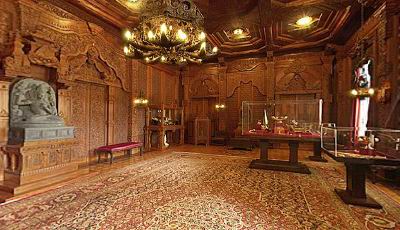Re: Bandjermasin Diamond Archived Message
Posted by Henri M  on November 30, 2011, 11:17 am, in reply to "Re: Queen Beatrix - Borneo Diamonds tonight" on November 30, 2011, 11:17 am, in reply to "Re: Queen Beatrix - Borneo Diamonds tonight"
Untl 1852 the State Regalia of the Sultanate of Bandjermasin was in use by the Sultan. After 1852 there were problems with the succession in the Sultanate, pretenders disputing each other. In 1859 the Dutch colonial Government took over the power in Bandjermasin and seized the properties of the Sultan. Among the spoils there was a rough diamond weighing 70 carats. Named the Bandjermasin Diamond, it was decided to send the impressive sized diamond to the Museum of Natural History in Leyden for public display. Yet, for some reason, the museum’s board of directors rejected the specimen.
After recovering from the rebuke, the Department of Colonies tried to sell the diamond. The Department learned that there were no buyers for this diamond. Believing it was the size of the Banjdermasin that was scaring off suitors, the diamond was submitted to the firm of E. and J. Israëls in Amsterdam for cutting. The result produced a squarish-shaped 40 carat white diamond. The reduced sized diamond still did not attract a buyer.
The Department of Colonies then planned to display the now altered diamond at the Rijksmuseum in Amsterdam as an historical item. This was abandoned because the Rijksmuseum decided that the changed (and therefore “new”) diamond had no historical significance. The stone was again turned over to E. and J. Israëls, this time with instructions to sell it. This was unsuccesful and finally in 1902 the diamond was returned to the Department of Colonies.
Meanwhile, in another part of the Dutch East Indies, the jewels from the Rajah of Lombok were confisquated and displayed at the Rijksmuseum. It is during this display of the Lombok jewels at the Rijksmuseum that the Bandjermasin Diamond finally made its appearance.
When the Republic of Indonesia was established in 1949, the Dutch government negotiated the return of almost all confiscated jewelry. Ironically, the disrespected Bandjermasin was not amongst these, remaining the property of the State of the Netherlands only to be stored away for many years in a vault unviewed by anyone. It is not until 2001 that the Bandjermasin finally reappeared at an exhibition Musée National d’Historie Naturelle in Paris. Since that time it is publicly displayed at the Rijksmuseum in Amsterdam.
For the good order, the Indian treasures and jewels in the collection of the Orange-Nassaus were all gifts from the Sultans, Rajahs and Emirs to the Kings/Queens of the 'Motherland' and were no part of confisquating policies by the State of the Netherlands.
Bandjermasin Diamond

There is a special "Indian Hall" at Noordeinde Palace in The Hague were some of the very valuable gifts from "the East" to the Orange-Nassaus in the past 400 years are privately displayed (for the royal family only).

|
Message Thread:
- Queen Beatrix - Borneo Diamonds tonight - Gert-Jan November 29, 2011, 1:50 pm
- Re: Queen Beatrix - Borneo Diamonds tonight - Hans November 29, 2011, 3:10 pm
- Queen Beatrix - Borneo Diamonds last night - Marianne November 29, 2011, 9:42 pm
- Re: Queen Beatrix - Borneo Diamonds tonight - Henri M November 30, 2011, 1:52 am
- Re: Queen Beatrix - Borneo Diamonds tonight - John R November 30, 2011, 3:47 am
- Re: Bandjermasin Diamond - Henri M November 30, 2011, 11:17 am
|
|

